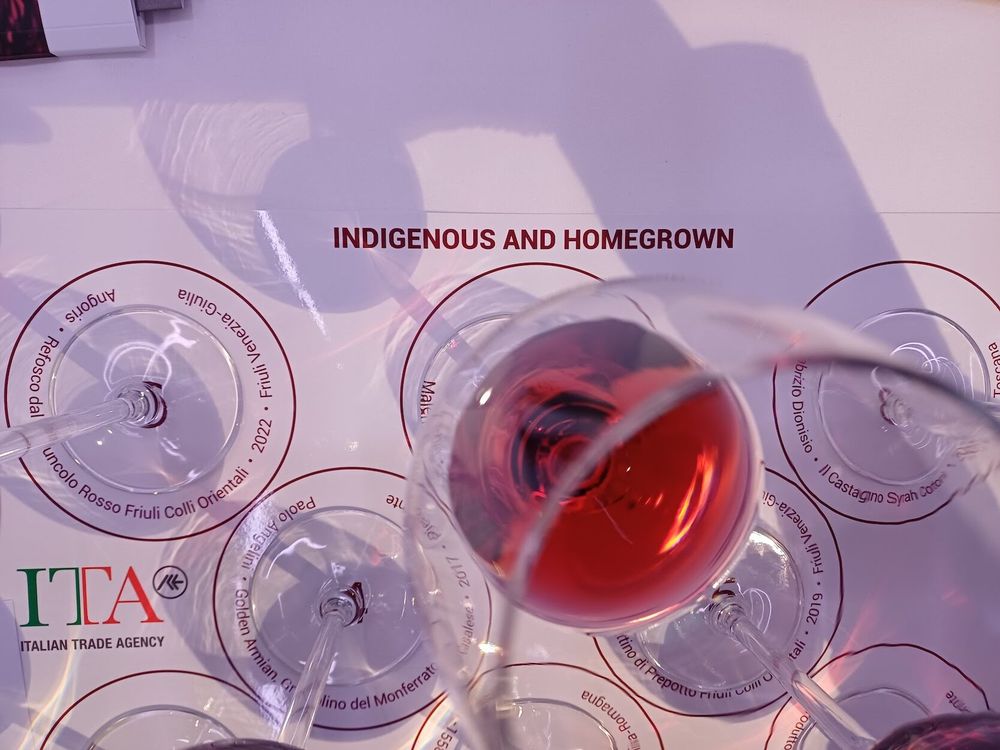“While I thought the wines were more interesting works in progress than the finished article, it seems inevitable that we are going to have to adapt our wine grape vocabulary to include at least some of these new names,” reports Dougherty from Borsa Vini Italiani.

Range of wines at Borsa Vini Italiani showing Italy’s sheer diversity, October 4, 2023
Italy shows it holds at least some of the cards when it comes to facing the challenges of climate change, as demonstrated at the recent Borsa Vini Italiani tasting in London.
Thrown into jeopardy by a threatened tube strike (on top of the scheduled rail strike), the annual tasting of wines from across Italy was, in the end, well attended, as the strike was called off just one day beforehand. Visitors were able to try over 300 wines (plus amari, liqueurs and spirits) from 54 producers, many of them looking for representation in the UK – in fact, only six already had importers. From Piemonte to Puglia and onto Sicily, the full length and breadth of the Italian peninsula was represented.
Italy is the second biggest supplier of wine to the UK and continues to grow. According to ITA (Italian Trade Agency) London Director, Giovanni Sacchi “This year’s trade figures [show] an increase of almost 14% year-on-year of the value of Italian wine exports to the UK in 2022.”
Like every other wine producing country, Italy’s growers are facing a growing and complex set of challenges as a result of climate change. But could Italy be one of the best placed countries to counter the threats that climate change poses?
Italy is notable for its hugely varied terrain – only 20% of the country is classified as flat land (the Po river valley in the north) with the rest either hills or mountains. This translates to a huge variety of altitudes and exposures for growers to turn to. Planting higher can be one strategy to escape rising heat levels, but it’s not a panacea and brings its own risks. Higher plantings can expose vines to more extreme weather, increase the risk of frost damage and will usually entail higher production costs.
In terms of grape varieties, of course there were plenty of Chardonnays, Pinot Grigios, Merlots and Sangiovese-based wines on show at Borsa Vini Italiani, but also many varieties that are unique to Italy.

Walter Speller, Borsa Vini Italiani
As well as growing the more mainstream international grape varieties, the country is home to hundreds of native varieties. Many of these have had no great success thus far outside their region of origin. But now, as growers look for varieties which might withstand heat and/or other problematic conditions, some previously neglected varieties are beginning to find their place. This multiplicity of varities is “Not the sole solution to an unprecedented and complex problem, but [it is] a key part of the picture,” said Walter Speller, Italian wine expert and Italy editor for Jancis.Robinson.com during a masterclass on some of these under-represented varieties.
For while overall warming temperatures are the long-term trend, there is no straight-line progression and annual challenges look set to continue. This year, for example, saw widespread instances of peronospera (which causes downy mildew), bouts of disastrously heavy rain, and catastrophic hailstorms in parts of the country in August. And our expectations can also be confounded, for example, when in very hot years like 2023, wines from the south and Sicily can end up being harvested later than their northern counterparts, as the vines shut down in higher temperatures and take longer to reach ripeness.
As well as native varieties, Italy is among the leaders in the growing category of PIWIs (fungal disease-resistant hybrids). Le Carrezze Organic Winery (looking for an importer) specialises in this area, showing wines made from, amongst others, Sauvignon Kretos, Johanniter and Fleurti. While I thought the wines were more interesting works in progress than the finished article, it seems inevitable that we are going to have to adapt our wine grape vocabulary to include at least some of these new names.

Masterclass at Borsa Vini Italiani examined the range of grape varieties
Of the traditional native varieties on show, these are the ones which piqued my interest:
- Schioppettino, described by one grower as “The Pinot Noir of Friuli, with a nose of Syrah”, this perfumed, peppery variety, native to Friuli, nearly died out completely post-phylloxera, but its qualities are now being appreciated. Recommended producers: Vigna Petrussa and Venchiarezza (both looking for importers).
- Refosco dal Peduncolo Rosso, praised by Pliny the Elder and, apparently the favourite wine of Livia (second wife of Augustus Caesar), this is a grape variety with a long and distinguished pedigree. With a name meaning Refosco ‘with the red stem’, it makes plummy and dark berry flavoured, deeply coloured wines with high acidity (and usefully good resistance to rot). Recommended producer: Tenuta di Angoris (imported by Hay Wines and Colosseum Wines)
- Canaiolo, a long permitted variety in Chianti, it is now becoming popular in its own right. In the blend with Sangiovese it was valued for adding softness, roundness and colour. As well as those basic roles, it can also bring aromas of strawberries, flowers and herbs. Recommended producer, Malenchini (looking for an importer).
- Luca Caporale of Venchiarezza

Italy shows that today it continues to offer quality and, perhaps most importantly, variety for UK buyers. In the future, that breadth of grape varieties could be one of the keys to a sustainable and successful wine industry in Italy.
































